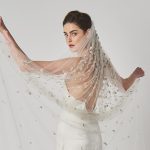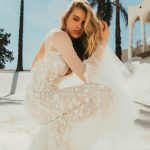It might be nothing more than a slip of tulle, but a veil can completely transform your wedding look. Whether you’re wanting to keep things totally old-school and traditional or opt for something slightly playful (hello eye-catching embellishments), it’s likely there’s a veil to suit your bridal style.
Curious? We’ve gathered some need-to-know tips for wearing these beauties and we’ve broken down the most common styles – you’re welcome!
Related article: 30 celeb wedding dresses we’re loving

From the wedding of Stephanie + Anders
Top tips
If you’re tall, try a fingertip- or waltz-length veil, or go for elbow-length if you’re petite. This will also allow any detailing on the back of your dress to show – just make sure it ends either just above or just below where your bodice begins, or it will visually cut you in half. Similarly, if your veil has any detailing make sure it begins below ornamentation on your dress, otherwise they’ll clash.
Another thing to consider is the ‘style’ of your wedding. A blusher or elbow-length veil will work for an informal affair, while an elbow, fingertip, flyaway or waltz-length veil will suit a semi-formal event. For a very formal wedding, choose a long cathedral veil that sweeps the floor, or perhaps a double-tier or chapel-length veil that extends to the floor.
Finally, the shape of your face should also come into play. ‘Square’ or ‘prominent’ faces often suit a longer veil, while one that falls straight down is great for a ’round’ face. ‘Heart-shaped’ face? Try a veil that falls behind the neck. A double-tier design can add width to an ‘oblong’ face, while ‘oval’ faces suit pretty much any style.

From the wedding of Emily + Nathan
How to wear your veil
Veils with extra gathers are best worn forward on the head, giving extra height to the bride. Going for something with no gathers? Position the veil towards the back of your head.
If your veil isn’t particularly billowy but doesn’t flow directly straight down, it’ll suit being worn both ways – have a play around and see what feels comfortable and flattering to you.

From the wedding of Holly + Jesse
Veil styles
Not clued-up on the different types of veils?
Don’t worry, we’ve put together a quick guide to the most popular styles…
THE BLUSHER
A short, single layer worn over the face, then lifted back over the head during the ceremony. If not worn over the face it can be used as another layer.
Best for: Dresses of any style at semi-formal and formal weddings.
THE CATHEDRAL
A very formal and dramatic veil that trails about 5cm beyond the train.
Best for: very formal full-skirted wedding dresses – with a cathedral train and blusher veil – at very formal affairs.
THE CHAPEL
A veil that extends to the floor about 10cm beyond the back of your dress; may have multiple layers or a blusher veil.
Best for: formal, full-skirted wedding dresses with no train or with chapel or short train, at formal weddings.
THE DOUBLE-TIER
A veil of two layers, usually of different lengths (either two veils, or a veil and blusher).
Best for: Works well with most gowns.
THE ELBOW
Extends to the bride’s elbow. May also be paired with longer layers.
Best for: Short or slimming wedding dresses at informal, daytime affairs.
THE FINGERTIP
The most versatile style of veil; it reaches fingertips when arms are relaxed.
Best for: Wedding dresses of any silhouette (especially popular with ball gowns), at semi-formal or formal affairs.
THE FLYAWAY
A multi-layered veil that just brushes the shoulders and gives a clear view of the back of the wedding dress.
Best for: Ankle-length gowns worn at less-formal affairs.
THE WALTZ
A veil that falls to somewhere between the knee and ankle.
Best for: Ankle-length wedding dresses worn at semi-formal affairs.
THE MANTILLA
A traditional Spanish veil trimmed with lace that’s worn over the head and shoulders.
Best for: Most dress styles and lengths, especially if you’re tying the knot at a church or somewhere with a heritage look.
THE JULIET CAP
A charming style popularised in the 1920s, juliet cap veils sit close to the head and usually gather at the ears before flowing down.
Best for: Flowy bohemian style dresses, especially ones embellished with floral or celestial-inspired motifs.
To find the perfect veil for your wedding dress, head to our directory of fabulous local designers…
Feature image from the wedding of Belinda + Anthony
Related posts:
 Gorgeous Alexandra Grecco veils to inspire your look
Gorgeous Alexandra Grecco veils to inspire your look
 Wedding dress trends: Pantsuits and jumpsuits
Wedding dress trends: Pantsuits and jumpsuits
 Wedding dress trends: Colour pop
Wedding dress trends: Colour pop
 Wedding dress trends: Off-the-shoulder styles
Wedding dress trends: Off-the-shoulder styles
 Wedding dress trends: Show-stopping sleeves
Wedding dress trends: Show-stopping sleeves
 Ready-to-wear or couture? Wendy Makin Bridal Designs shares advice
Ready-to-wear or couture? Wendy Makin Bridal Designs shares advice
 Wendy Makin Bridal Designs shares tips for first wedding dress consultation
Wendy Makin Bridal Designs shares tips for first wedding dress consultation
 The trends celeb-favourite wedding insiders are loving
The trends celeb-favourite wedding insiders are loving

